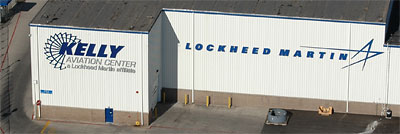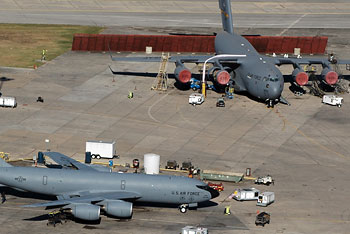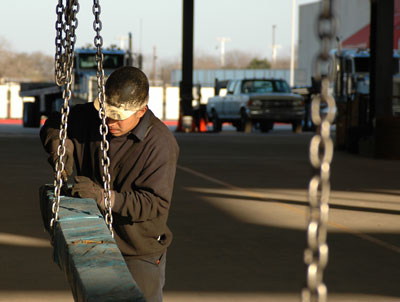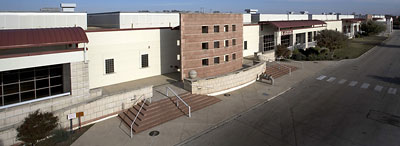BRAC Transition Era at Kelly Field
By the late 1980’s and early 1990’s the waning of the Cold War saw significant downsizing of U.S. Department of Defense budgets, resulting in a comprehensive reassessment of America’s military missions throughout the world. In 1993 Kelly Air Force Base and the San Antonio Air Logistics Center were first placed on the Base Realignment and Closure Commission’s list of sites at risk of closure. In 1995 the Commission voted to close the San Antonio Air Logistics Center at Kelly and realign some missions to the adjacent Lackland Air Force Base. It was feared that an estimated 10,000 to 13,000 jobs would be lost at Kelly, which by then was the single largest employer in the region.
Fortunately for San Antonio, the community was given a six-year time frame between the announcement and the date of official closure, providing time to develop and execute a plan of transition.
Immediately, city and state authorities worked to create an organization that would accept the handing over of Air Force property at the Kelly site and its necessary redevelopment to ensure the preservation and creation of jobs for the region. In 1995 the redevelopment authority - the Greater Kelly Development Corporation, GKDC was established by resolution of the San Antonio City Council and incorporated as a Texas Development Corporation, a political subdivision of the State of Texas.
The authority was restructured in 1997 to accept federal property as the Greater Kelly Development Authority (GKDA). In 2006 it was reorganized as the Port Authority of San Antonio, doing business as Port San Antonio, as it is known today. The organization is led by a board of directors appointed by the San Antonio City Council and its strategic plan and day-to-day activities are managed by a President and CEO.
 The organization first focused on leveraging existing Air Force aircraft maintenance, repair and overhaul facilities and workforce to retain as much of that work as possible within the region as the military also transitioned to outsourcing aircraft depot work to private contractors. Accordingly, Boeing and Lockheed Martin were among the first key customers at the site.
The organization first focused on leveraging existing Air Force aircraft maintenance, repair and overhaul facilities and workforce to retain as much of that work as possible within the region as the military also transitioned to outsourcing aircraft depot work to private contractors. Accordingly, Boeing and Lockheed Martin were among the first key customers at the site.

Lockheed Martin
The Kelly Aviation Center (KAC) emerged as a partnership that included Lockheed Martin, Rolls Royce and, initially, General Electric, servicing F100, TF39 and T56 engines for the military. Across from KAC, The Boeing Company took on the maintenance, repair and overhaul work of several Air Force workhorses, including the C-17, KC-10, KC-130 and C-135. More than a decade later, the two organizations have remained and grown at the site, serving as a cornerstone that has helped provide thousands of aircraft maintenance jobs that were feared to have been lost when the closure of Kelly Air Force Base was first announced.

These two key aerospace customers have also served as a catalyst to attract related contractors, including StandardAero, New Breed Logistics, Chromalloy Component Services and other aerospace firms. Today, an estimated 3,000 workers at Port San Antonio are employed by the private aerospace-related companies at the site.
The Port Authority also attracted a diverse array of other industries to the site. Triple-S Steel arrived in 2003, entering into a land lease with the Port Authority to develop its own warehouse and distribution center for industrial steel products. In 2008 Fiesta Warehousing and Distribution relocated from elsewhere in San Antonio to occupy 315,000 square feet at a new warehouse at East Kelly Railport that private developer RREEF completed that year (part of a two-warehouse project at the railport, with a second adjacent facility added in 2009).

 Customers like ACS, a business services provider that began as a Lockheed Martin subsidiary at Port San Antonio in 2000, grew significantly over the course of the Port’s first decade. ACS, now part of Xerox, had grown from an initial workforce of slightly more than 100 to over 1,000 today.
Customers like ACS, a business services provider that began as a Lockheed Martin subsidiary at Port San Antonio in 2000, grew significantly over the course of the Port’s first decade. ACS, now part of Xerox, had grown from an initial workforce of slightly more than 100 to over 1,000 today.
All the while, as private sector employers began growing at the Port during the opening years of the 21st century, the military, which had been the site’s driving force for most of the preceding 100 years, saw a rebirth at the site despite the closure of Kelly Air Force Base in 2001.
The handover of property from the Air Force to the Port Authority did not happen in a single transaction. Rather, a schedule was established under a 2001 leaseback agreement whereby tracts of land and buildings would come under Port control at various times, allowing the two parties to respectively vacate and assume control of real estate assets in an orderly fashion.
As a result of additional BRAC decisions handed down in 2005, the Air Force was required to transfer personnel to active base properties throughout the world. Under its original leaseback agreement with the Port, the Air Force retained control of certain properties at the former Kelly site that allowed it to meet the latest BRAC requirements to consolidate operations.
However, while the buildings it still occupied at Port San Antonio gave the military several places to relocate off-base personnel, their relatively small size and scattered distribution limited their efficient use. Rather than fragmenting agencies, the Air Force developed a plan to consolidate a dozen agencies and 3,000 staff from throughout the country under a single roof in the Port’s Building 171, a 450,000 square-foot facility dating to the 1940’s.

